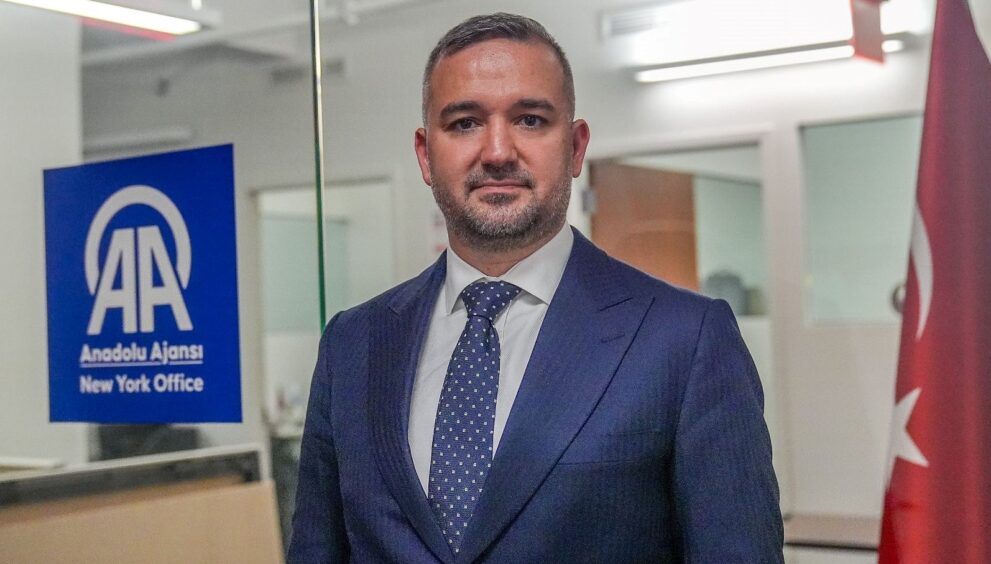Central Bank Governor Karahan: We will do whatever it takes to achieve the inflation target

Central Bank Governor Fatih Karahan stated that they will do whatever it takes to reach the 24% inflation target. Karahan emphasized that the transition to the Turkish Lira is higher than switching to foreign currency.
During his meetings in the USA, Turkey’s Central Bank (CBRT) Governor Fatih Karahan visited the Anadolu Agency’s New York Office. Responding to questions on the agenda, Karahan said they attribute the recent decline in inflation not only to base effects, but also to the main trend drop due to tight monetary policies.
Karahan pointed out that the improvement in the main trend will be effective in the remaining part of the year regarding the decline in inflation, stating, “We will do whatever it takes to achieve our year-end inflation target of 24%.” Emphasizing that they will continue their tight monetary policy stance, Karahan expressed that maintaining demand at de-inflationary levels is crucial for the ongoing decrease in inflation.
“Transition to the Turkish Lira higher than to foreign currency”
Stating “We will not allow demand conditions to disrupt the de-inflation process,” Karahan drew attention to the higher transition rate to the Turkish Lira from individual foreign exchange protected deposit accounts compared to switching to foreign currency. Indicating that the main priority in determining the policy rate in the upcoming period will be to ensure the required tightness to follow the de-inflation path, Karahan commented, “We will continue our tight monetary policy stance until a permanent decrease in inflation and price stability are achieved.”
Karahan’s responses to various questions cover topics from fighting inflation to monetary and interest rate policies, currency-protected accounts, transition to the Turkish Lira, and foreign currency loans. In January, inflation came out high, but we saw a decline again in February. How should we interpret upcoming inflation data? Annual inflation has been decreasing since its peak in May 2024. A significant part of the drop observed in the early months of the de-inflation process was due to base effects created by developments in the summer of 2023. In this period, we were focusing on guiding expectations related to the policy rate based on monthly price developments. Consequently, we were looking at the recent trend of seasonally adjusted main indicators. At this point, we evaluate that the decline in inflation is due to the main trend drop, besides base effects, with the impact of tight monetary policies. We expect that the improvement in the main trend will contribute to the decrease in inflation for the rest of the year. Furthermore, there are instances where seasonal adjustment methods fail to capture the changing seasonality post-pandemic. Taking all this into consideration, we find it more appropriate to compare the main trend indicators with the same month of the previous year. Looking at the February main trend indicators, we observe that the seasonally adjusted B index fell from 4.3% in 2024 to 2.8% in 2025, and the C index from 3.7% to 2.4%. It is known that these two indices tend to increase due to transient…
“To reach the target, we will do whatever it takes”
Understanding inflation dynamics, it is also beneficial to look at subcomponents of inflation. In terms of annual inflation developments, we consider that while the inflation in goods is low, there are still high levels in services due to time-dependent price setting and indexing to past inflation. Rent inflation decreased from 121% in February last year to 97% this year. In this category, de-inflation is slow and at a high level. We also observe a limited improvement in education. On the other hand, we see a significant improvement in items in the service group that are more sensitive to monetary policy. For example, restaurant and hotel inflation decreased from 95% to 46%. This shows that the monetary tightness is effective in reducing such service inflation. We will do whatever it takes to reach our year-end inflation target of 24%. By maintaining our tight monetary policy stance, we will continue to reduce inflation in line with our year-end targets. The demand showed strong growth in the fourth quarter of last year. What does this data mean for the inflation outlook? Before the national income data for the fourth quarter is announced, we were monitoring data such as card payments, credit growth, and retail sales to understand demand conditions. These data indicated that demand was somewhat resilient but at de-inflationary levels in the fourth quarter. The relevant growth data announced at the end of February revealed that the demand was stronger than anticipated. As a result, we highlighted this in the recent PPK decision text. Maintaining de-inflationary levels in demand is essential for the continuous decrease in inflation. Looking at the data released for the first quarter, we see that retail sales remained strong in January, while vehicle…
“We do not have a foreign exchange rate target”
In January, we saw an increase in the current account deficit. Your policy texts continue to emphasize real appreciation in the Turkish Lira. Can you evaluate the outlook for real appreciation and the current account for 2025? When we look at the development of the current account balance, we see that the ratio of the current account deficit to national income decreased from around 5% before tightening to 0.8% by the end of 2024. Considering that the average ratio of the current account deficit to national income over the last 20 years is around 3.7%, the 0.8% ratio is significantly lower. Recent data, however, indicate some increase in the current account deficit in 2025. When looking at the factors that may affect the current account in 2025, uncertainties related to global trade highlight downward risks emanating from exports. We have also witnessed a high trend in consumer goods imports recently. Despite these, we expect the current account deficit to remain below historical averages in 2025, albeit higher than in 2024. Regarding real appreciation, our monetary policy is not designed with a focus on real appreciation in the Turkish Lira. We do not have any target regarding the level or change in exchange rates. Our determined stance in monetary policy increases the interest in the Turkish Lira. As a natural consequence of this interest, our reserves increase, leading to real appreciation in the exchange rate.
“We will continue our tight monetary policy stance”
To evaluate the near-term outlook, we can look at the preferences of domestic residents. There has been a decline in Turkish Lira deposit interest rates and an increase in the withholding tax rates for Turkish Lira deposits and money market funds. We also took steps to accelerate the






















































































































































































































































































































































































































































































































































































































































































































































































































































































































































































































































































































































































































































































































































































































































































































































































































































































































































































































































































































































































































































































































































































































































































































































































































































































































































































































































































































































